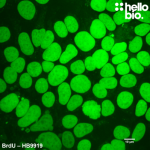Amyloid-β
Amyloid refers to abnormal fibrous and extracellular deposits found in various tissues. Amyloid fibers and oligomers are associated with Alzheimer’s disease and amyloid-β peptides (e.g. β-Amyloid Peptide (1-42)) are a predominant component of amyloid plaques. Methoxy-X04, Thioflavin T (ThT) and the next generation Thioflavin X (ThX) are used to stain amyloid. Researchers can make big savings on Amyloid-β related peptides and products, our prices are around 25-50% less than other suppliers.
- Description:
Identifies early apoptotic, necrotic and viable cells
- Description:
Detects apoptosis by staining phosphatidylserine molecules translocated to the outside of the cell membrane.
BrdU (5-Bromo-2′-deoxyuridine) (HB0979)
Description:Thymidine analog. Widely used to identify proliferating cells, enhances Yamanaka factor reprogramming
Purity:>98%
- Description:
Fluorescent adenosine receptor agonist
- Description:
Fluorescent A3 adenosine receptor antagonist
- Description:
Fluorescent β2 adrenoceptor antagonist












![CA200623 CellAura fluorescent adenosine agonist [NECA]](https://cdn.hellobio.com/media/catalog/product/cache/94284e7e2aa0585672abd2efa52d46dd/h/b/hb7813-ca200623-image1-fl_result.jpg)
![CA200645 CellAura fluorescent adenosine A<sub>3</sub> antagonist [XAC]](https://cdn.hellobio.com/media/catalog/product/cache/94284e7e2aa0585672abd2efa52d46dd/h/b/hb7812-ca200645-image1_1.png)
![CA200656 CellAura fluorescent β<sub>2</sub> antagonist [(±)-propranolol]](https://cdn.hellobio.com/media/catalog/product/cache/94284e7e2aa0585672abd2efa52d46dd/h/b/hb7820-ca200656-image1_1.jpg)